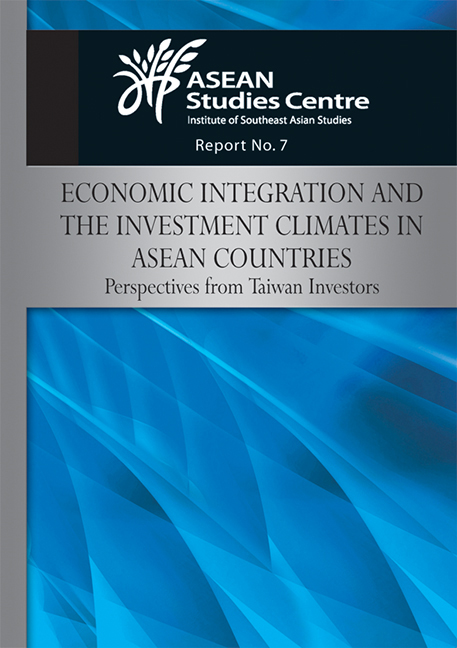 Economic Integration and the Investment Climates in ASEAN Countries
Economic Integration and the Investment Climates in ASEAN Countries from I - Economic Integration and the Investment Climates in ASEAN Countries: Perspectives from Taiwan Investors
Published online by Cambridge University Press: 21 October 2015
3. Dr Michael Hsiao H.H., Executive Director, CAPAS, welcomed the participants and acknowledged the initiative of ISEAS Director Ambassador K. Kesavapany in 2007 in setting the train of process that led to the seminar in Taipei.
4. Mr Rodolfo C. Severino, Head of the ASC, emphasized that, as there was limited contact between ASEAN and Taiwan, it was good to take a closer look at the relationship. In doing so, two elements of trade and investment relations must be brought forward: (a) the economic relationship between ASEAN and Taiwan; and (b) investor's opinions of the integration process with a view to improving the investment environment.
5. Dr David Hong, President, Taiwan Institute of Economic Research (TIER), stated that it was a great time for Taiwanese investors to observe ASEAN integration. Taiwan started looking at Southeast Asia in the 1970s, when the country ran into trouble with labour shortages, wage hikes, land price increases, environmental protests, and the appreciation of the New Taiwan dollar. After ten years in Southeast Asia, the investors started to move into China, which gave them a larger comparative advantage. After twenty years in China, the Taiwanese businesses started to feel pressure — wage hikes and increased competition. Hence, with the current global economic crisis, it was the right time for Taiwanese investors to look into other options for the future. Moreover, Taiwan was too dependent on China, and there was an urgent need to diversify its investments. It was in this light that Taiwan needed to look at Southeast Asia again as an important destination for future investments.
To save this book to your Kindle, first ensure [email protected] is added to your Approved Personal Document E-mail List under your Personal Document Settings on the Manage Your Content and Devices page of your Amazon account. Then enter the ‘name’ part of your Kindle email address below. Find out more about saving to your Kindle.
Note you can select to save to either the @free.kindle.com or @kindle.com variations. ‘@free.kindle.com’ emails are free but can only be saved to your device when it is connected to wi-fi. ‘@kindle.com’ emails can be delivered even when you are not connected to wi-fi, but note that service fees apply.
Find out more about the Kindle Personal Document Service.
To save content items to your account, please confirm that you agree to abide by our usage policies. If this is the first time you use this feature, you will be asked to authorise Cambridge Core to connect with your account. Find out more about saving content to Dropbox.
To save content items to your account, please confirm that you agree to abide by our usage policies. If this is the first time you use this feature, you will be asked to authorise Cambridge Core to connect with your account. Find out more about saving content to Google Drive.